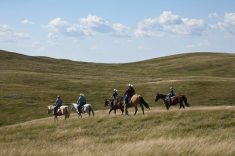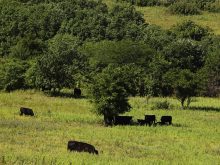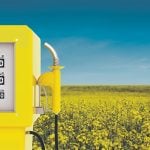Waters seems to be on our mind these days and little wonder — one in 300 year events are unfolding as I write in mid May. In this article I will show a few photos on my Blackstrap Farm, east of Dundurn, Sask., and explain what is happening. All photos were taken May 14, 2011.
Photo 1 is on a road and the white stuff is not snow but salt. Water is running down the edge of the road despite the fact there has only been 0.6 inches of rain so far this year and that came 10 days earlier. What we are witnessing is artesian discharge of water. The soil salinity here and throughout much of the Allan Hills is caused by artesian discharge from “finger aquifers” that snake through the countryside and lie beneath drainage channels.
Read Also

How we combine stock and option strategies
Options can enhance an investor’s returns — but should only be considered after significant and successful experiences with stocks, including a vicious bear market, Herman VanGenderen writes.
With the 20 inches of rain last summer and big snow last winter, the aquifers are pressured up and the spring we see here is where the water found a direct path to the surface.
Photo 2 is on my home quarter where I have seeded canola this year. The strip next the road has been left for another week because the dark coloured part of it is wet. It is on a side hill where no water sits even in spring. The aquifer under
this area continues on to the next quarter section where white crusts are in full bloom after only a few warm sunny days (see Photo 3). There were about 30 acres in that quarter that could not be seeded in 2010 because there was no access to the area that was dry enough.
So, the aquifers are pressured up to highs not seen in decades and we can expect the effects to last a few years. As the dry cycle returns, white crusts will be staring us in the face in places the current generation has not seen before. The observation wells monitored by Saskatchewan Watershed Authority show the long memory of the pressure head on some of these aquifers.
Photo 4 is also on my home quarter and shows a slough that was pumped dry. Some water came back, despite no runoff from rain. That means that the surrounding water table is higher than the bottom of the slough and the new water that appeared is groundwater seepage, no artesian phenomenon here. The slough is actually functioning as a well, much like a sump pump in a house.
There have a few observations and interpretations. Maybe some of these will help explain some of the strange things you are seeing in your neck of the woods.
J.L.(Les)HenryisaformerprofessorandextensionspecialistattheUniversityofSaskatchewan.HefarmsatDundurn,Sask.Herecentlyfinishedasecondprintingof“Henry’sHandbookofSoilandWater”,abookthatmixesthebasicsandpracticalaspectsofsoil,fertilizerandfarming.LeswillcovertheshippingandGSTforGrainewsreaders.Simplysendachequefor$50toHenryPerspectives,143TuckerCres,Saskatoon,SK,S7H3H7,andhewilldispatchasignedbookposte-haste















